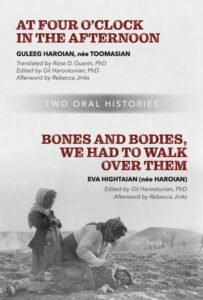 Book Review | At Four O’clock in the Afternoon and Bones and Bodies, We Had to Walk Over Them
Book Review | At Four O’clock in the Afternoon and Bones and Bodies, We Had to Walk Over Them
Written by Guleeg Haroian and Eva Hightaian
Translated by Rose D. Guertin, Ph.D.
Edited by Gil Harootunian, Ph.D.
Two oral histories are combined in one collection. At Four O’clock in the Afternoon is the only existing firsthand oral account of an adult female who survived both the 1895 Hamidian massacres and the 1915 Armenian Genocide. Bones and Bodies, We Had To Walk Over Them is the firsthand oral account of her nine-year-old daughter who survived the Genocide.
Both accounts were translated by Rose D. Guertin, Ph.D. and written and edited by Gil Harootunian, Ph.D. This stunning collection is told in four voices.
Dr. Harootunian’s voice provides the introduction to both oral histories with thoroughly researched facts and a relevant overview that shine a light on key points that may have been dimmed during the emotional narration or translation in language. She states there are many reasons why self-narrated histories were not written by women, including but not limited to the lack of literacy skills and the community taboo that precludes females discussing their sexual trauma.
Guleeg (Toomasian) Haroian narrates At Four O’clock In the Afternoon, starting her story at the age of 10, when she witnessed the killing of her father, the theft of their wealth and the burning of their house down to ashes by the Turks. By 1913, she was married to Hagop Haroian, blessed with two daughters and pregnant with a third, when he left for America with the dream of saving money to bring his family a life of freedom. With dreams shattered, she survived the 1915 Genocide through a forced marriage to a Muslim and later reunited with her daughter.
Excerpt: “And soon the crier yelled for us to go. I jumped. I knew that place so well! I ran. They had begun separating the pretty ones, the brides, for rape, marriage and property. They were raping and beating them, then driving them out…I escaped. I had a stick in my hand. I was in my thirties; my eyes and face I had rubbed all black mud on, so the Turks wouldn’t recognize me, and they wouldn’t see how young I was…From roof to roof, I jumped.”

Eva (Haroian) Hightaian, Guleeg’s only surviving daughter from “the old country,” narrates Bones and Bodies, We Had to Walk Over Them. Eva’s oral history is significant, as she reveals the decision-making process of a nine-year-old child experiencing the collections, the Death March and forced transfer into a Muslim household. Eva also talks about her years with an Arab adoptive mother and her reluctance to re-join her mother and the Armenian community.
Excerpt: “After the Turkish government took all the ammunition and everything they saw, they decided you still have more…The soldiers took the women they found to the konagh. They tortured them. No woman would talk about it, but you can imagine what they did to the women. …The Turkish soldiers collected all the old men. They took them to a gorge, shot them, and those old men fell right there…After that, the massacre time came…And now the Turks claim they never did such a thing. But I saw it with my own eyes, in my young days, my childhood, they did all those things…”
The afterword is written by Dr. Rebecca Jinks, Department of History, Royal Holloway, University of London, and a respected authority of women’s experiences during the Armenian and Yezidi genocides and humanitarian responses and representations in the aftermath. Her article “‘Marks Hard to Erase”: The Troubled Reclamation of ‘Absorbed’ Armenian Women, 1919-1927” was published in 2018 in the American Historical Review. Dr. Jinks provides a comparative analysis to a phenomenon called “genocidal absorption” that occurs when children are removed from the ethnic, religious and national communities that they are born into, as part of the process of group destruction. Dr. Jinks states that Guleeg and Eva’s experiences give us real insight into different experiences of genocidal absorption during the Armenian Genocide.
The book is just over 200 pages and flows smoothly for a quick read. However, the words on those pages will stay with you long after as you reflect on the unspeakable horror and remarkable resilience. Please note trigger warnings of violence, sexual trauma and genocide.
This level of firsthand accounts is a rarity, and their value cannot be understated.
It was not lost on me that this rare collection of Armenian history was written by a family matriarchy of four generations of women. The two oral histories consist of excerpts from recordings made beginning in 1976 with all four generations present. Had this not been a collaborative effort among trusted family members, these stories would join others that will never be told. This level of firsthand accounts is a rarity, and their value cannot be understated.
This treasure could not have been written by anyone other than Dr. Harootunian. We highly recommend this book for its rare and unique firsthand points of view, especially for readers and researchers interested in the lesser told stories from women that are written in English.
We also commend and thank Guleeg and Eva for their selfless bravery, for opening deep wounds and for reliving their nightmares, and Rose and Gil for pushing through their generational trauma to share this invaluable treasure with the world.



Be the first to comment